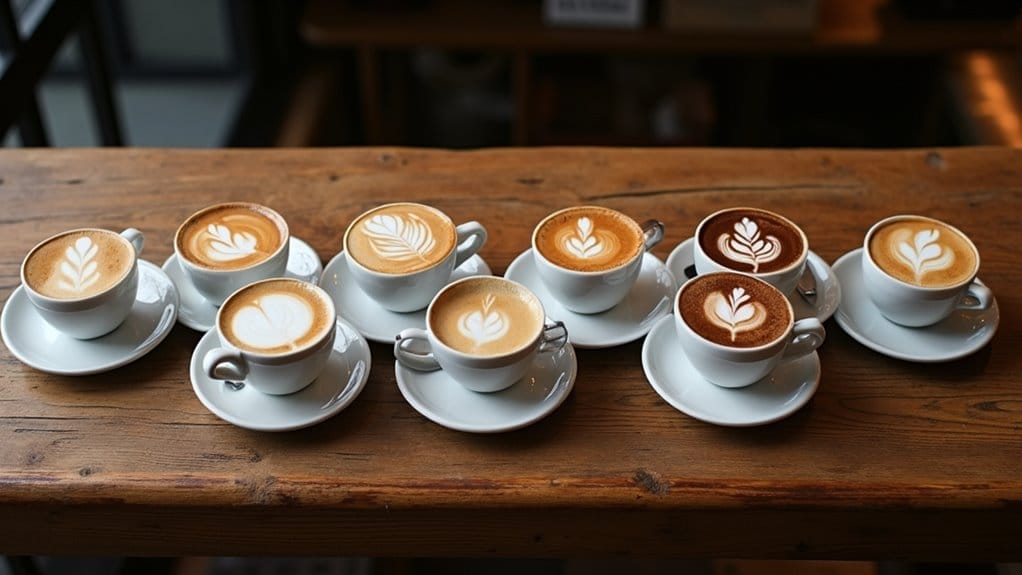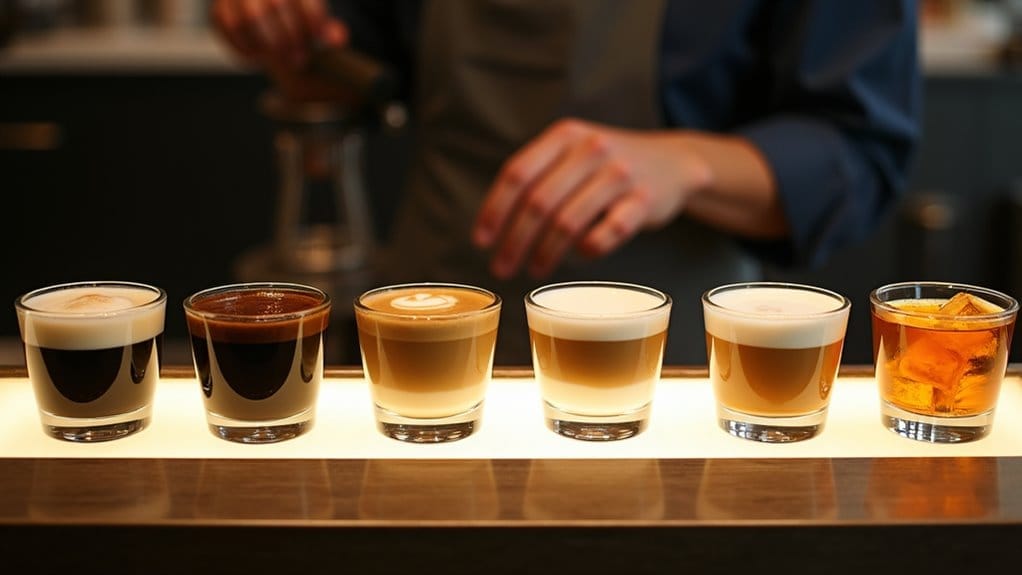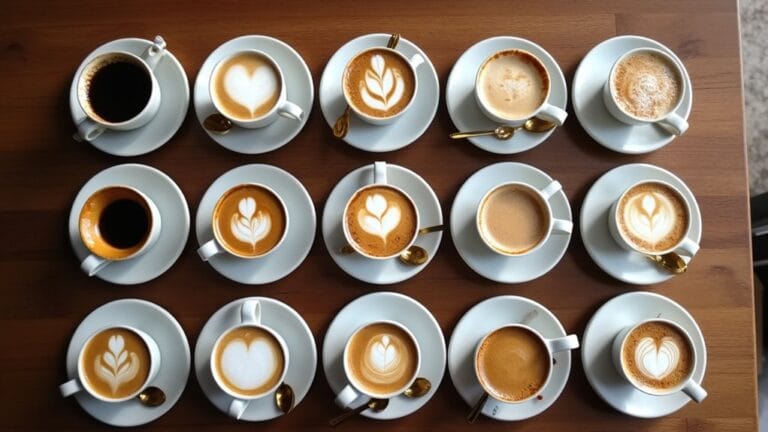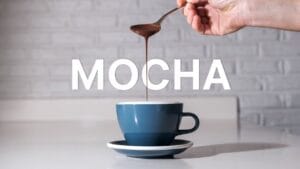Understanding Coffee Names and Types
Because coffee menus can read like secret codes, it helps to know that every name tells a fast, colorful story about what’s in the cup, how it’s made, and where it came from!
Grab a coffee types list: espresso, latte, cappuccino, Americano, mocha, cold brew—no big mystery. Words match steps—short shot, steamed milk, hot water splash—each tweak swaps taste and kick like flipping switches. Think “black” or “milk” as traffic lights. A classic mocha is always defined by its use of espresso as the core ingredient, providing a bold caffeine foundation.
Next, learn types of coffee drinks explained: macchiato gets a milk dot, flat white skips foam. Add iced, sweet, and boom—different coffee drinks explained, ready for ordering without sweating. For those wanting a double-shot jolt, ask for a doppio—two full espresso shots in one cup.
Coffee Basics: What Makes Each Drink Different
Every coffee name hides tiny instructions: espresso equals strong squirt, latte means milk blanket over a shot, cappuccino adds a foam hat.
These different types of coffee drinks share three core clues, and here they are:
- Brewing battles: pressure punches (espresso), gravity drips (pour-over), or coffee swims (French press). Each method affects the caffeine content due to varying extraction times; for instance, brewing time directly influences how much caffeine gets extracted.
- Roast signals: dark shouts bold, medium whispers sweet, light sings bright.
- Grind sizes: fine sand, chunky sea salt, or coarse snow dictate how water runs, shaping body, tang, and buzz. Together they forge the flavor profile that distinguishes a shot of ristretto from a tall Americano.
Once coffee drink types decode to these clear cheats, their quirks make sense, no wizard degree required.
Espresso-Based Coffee Names

While most folks just see rows of confusing names, every espresso drink is really a mini blueprint, a tiny recipe card disguised as a coffee!
| Name | Espresso | Extra |
|---|---|---|
| Doppio | Double shot | None |
| Cappuccino | One shot | Foam-top and equal milk |
| Flat White | Double shot | Thin creamy milk |
On any types of coffee drinks list, the espresso with milk name keeps popping up like whack-a-mole, and we still freakin’ love it! Latte? Latte macchiato? Piccolo? Different heights of milk! Then, add cocoa for mocha, swap cream for breve—boom! Ristretto is short, lungo long, americano watered, and names of different coffee drinks just keep goin’! Espresso serves as a base for popular drinks that showcase its robust flavor and silky milk texture.
Brewed Coffee Types and Names
Brewed coffee names start with the hot ways we make it—drip, French press, or Moka pot—, then switch to the cold side with stuff like icy flash brew or velvet-smooth nitro. Immersion methods, such as the French Press, yield rich and bold flavors, enhancing the variety of brewed coffee experiences. After that, quirky sips pop up—think whipped-cream-topped Vienna or the equal-parts cousin café au lait—, and every tiny twist gets its own loud, tasty label. Bourbon coffee, known for its high-quality beans, adds a unique flavor profile that is cherished in the specialty coffee market.
Hot Brewing Methods
Here are the hot brewing methods in easy steps:
- Espresso drinks like ristretto (tiny sweet shot) and lungo (bigger sip, plus Portugal’s bica) use fancy machines to blast super-fine grounds with pressurized hot water, making the base for many types of coffee drinks!
- Pour-over and drip mean you slowly splash water over medium grind in a funnel, so Chemex, auto-drip, or clever dripper can catch the clean juice.
- Steeping styles (French press, AeroPress) dunk coarse or medium grind, then separate grounds, delivering bold flavor with fuss-free, entry-level gear! The French Press method is particularly praised for its ability to retain coffee oils and flavors, resulting in a rich and authentic cup. Brewing with a 4-minute steep time is essential for balanced flavor development.
Cold Coffee Preparations
From the gentle slide of nitro foam to the brisk snap of ice cubes in a shaken espresso, cold coffee prep turns the bean into a whole rainbow of chill, each style trading heat for cool, sweet, or fizzy thrills.
- Chill-drip 24 h cold brew—steep coarse grounds, silky, mellow, 65% less acid.
- Flash-brew hot drip hits ice—bright, fast, flavor locked, perfect when you need speed.
- Nitro draft pumps tiny bubbles—creamy head, zero milk, still tastes like dessert, thanks to the infusion of nitrogen.
These cold brew coffee types pop on any different coffee drinks chart, slotting between latte and drip. Kids eye them, adults sip.
The kinds of coffee drinks now sport iced cousins: brown-sugar shaken espresso, sweet-cream nitro, condensed-milk viet, all cold, bold, and ready to rescue any summer meltdown with caffeinated glee.
Specialty Brewing Techniques
Every mug on the planet hides a story told by the brewer who made it, and these five superstar gadgets—pour-over, French press, drip machine, AeroPress, and siphon—each turn a handful of brown beans into a totally different flavor trip!
- Pour-over brewing drips hot water slow, giving bright, tea-like clarity.
- French Press Brewing steeps coarse grounds, so you sip bold, sludgy goodness.
- AeroPress Brewing squishes espresso-ish shots in thirty moments, smooth as sneakily stolen candy!
Specialty Coffee Names and Seasonal Drinks
As baristas jot frantic chalkboard shorthand each morning, the names glimmering on the menu shift like tiny weather systems, so let’s crack these codes fast!
- Dalgona whips like magic candy over milk, a fluffy selfie king.
- Gingerbread Latte hugs you with cookie spices, snowy days fuel.
- Peppermint Mocha swirls chocolate and mint into winter lights.
Specialty coffee types range from silky Nitro Cold Brew to the tiny but mighty Cortado, each wearing its own fancy hat, while seasonal coffee drinks such as the famous Pumpkin Spice parade yearly like rock stars.
Nitro Cold Brew glides, Cortado punches—seasonal stars strut back in pumpkin-cosmic glory!
Coffee drink names like Irish Coffee or sweet Vietnamese Coffee shout their stories loud, clear, and delicious!
How to Choose the Right Coffee for You

Pick coffee like you pick cereal—sweet or bold morning, mellow for chilling, and keep a map!
Initially, list the flavors you adore, such as berry zing or cocoa hug, then match bag tags to that list.
Next, size up where you’ll sip—espresso for speed, cold brew for desk, French press for couch—so each cup hits the spot.
Taste Preference Guide
When your tongue wants a morning hug instead of a slap, knowing the four big taste helpers turns coffee chaos into happy sips right from the initial gulp. This taste preference guide breaks it down so even kids get why one coffee feels like chocolate milk while another bites like lemon candy.
| Sweet Hug | Sharp Slap |
|---|---|
| Brown sugar, caramel, honey | Bright lemon, green apple |
| Syrupy, thick, cozy feel | Watery, light, zingy pop |
| Nutty almond, hazelnut | Floral jasmine, black tea |
| Milk chocolate swirl | Berry jam pop rocks |
| Smooth, no bitter burn | Sparkly tongue tingle |
Match the column you like to different styles of coffee drinks and skip the ones in the other box, simple as picking jelly-bean flavors!
Situation-Based Recommendations
Every hot cup of brown magic owns a secret job, and that job switches depending on who’s drinking it and why they’re awake in the initial place.
When someone has to sprint out the door, a straight espresso shot tackles the urgency without fancy coffee names slowing them down.
For lazy Sunday chats, creamy types of coffee drinks like a latte stretch minutes into smiles.
On a weekday at the desk, easygoing types of coffee beverages such as press-pot Colombian keep meetings painless, because high-forgiveness beans still taste sweet even if you eyeball the scoop.
Frequently Asked Questions
Do Coffee Names Vary by Country?
Demonstrably, names vary: espresso across Europe, Galao in Portugal, Ipoh in Malaysia. Climate, ingredients, and colonial trade histories differ: Nordic iced styles versus Turkish boiled tradition.
How Long Do Coffee Beans Stay Fresh?
Echoing Eden’s fleeting fruit, roasted beans stay pristine seven days opened, reasonable three weeks, ideal peaks two weeks unsealed after roast date before flavour echo fades to whispers.
Is Decaf Coffee Completely Caffeine-Free?
Decaffeinated coffee retains trace caffeine, approximately two to twelve milligrams per eight fluid ounces, because standard processes extract roughly ninety-seven percent, leaving residual amounts dependent upon bean, method, roast, and preparation variables.
What’s the Healthiest Coffee Option?
Less is more: black, hot-brewed, light-roast Arabica optimizes antioxidants and minimizes calories, aligning health goals; add-ins erode benefit, whereas this disciplined brew rewards patience.
Can I Mix Different Coffee Types?
Mixing different coffee types achieves synergy; balanced flavor emerges when complementary solubilities, origins, and roast levels converge.
References
- https://www.folgerscoffee.com/coffee/articles/types-of-coffee
- https://esquirescoffee.co.uk/news/beginners-guide-coffee-drinks/
- https://en.wikipedia.org/wiki/List_of_coffee_drinks
- https://www.asterpremium.com/a/blog/post/coffee-preparation-methods
- https://blog.bluebottlecoffee.com/posts/how-to-choose-a-brew-method
- https://www.kitchenaid.com/pinch-of-help/countertop-appliances/how-to-make-different-types-of-espresso-drinks.html





